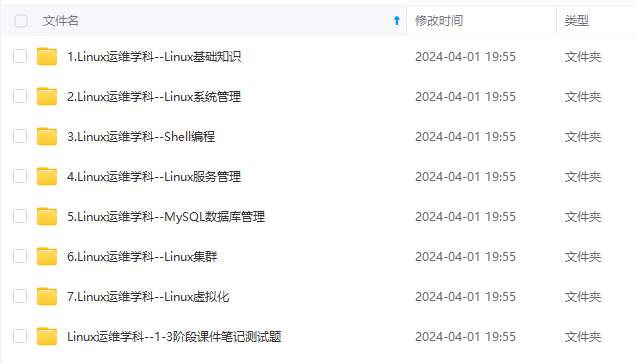kubernetes使用 (十七)helm工具--自定义chart
自定义chart包1. 使用名称创建chart目录[root@k8s-master01 ~]# helm create mychart[root@k8s-master01 ~]# cd mychart/[root@k8s-master01 mychart]# lschartsChart.yamltemplatesvalues.yaml#目录结构说明charts#普通目录Chart.yaml#用于配
·
1. 使用名称创建chart目录
[root@k8s-master01 ~]# helm create mychart
[root@k8s-master01 ~]# cd mychart/
[root@k8s-master01 mychart]# ls
charts Chart.yaml templates values.yaml
#目录结构说明
charts #普通目录
Chart.yaml #用于配置chart 的基本信息
templates #自定义yaml文件存放目录
values.yaml #全局变量文件2. 在templatest目录下创建yaml文件
cd templates/添加yaml文件
cat > deployment.yaml <<EOF
apiVersion: apps/v1
kind: Deployment
metadata:
creationTimestamp: null
labels:
app: web
name: web
spec:
replicas: 1
selector:
matchLabels:
app: web
strategy: {}
template:
metadata:
creationTimestamp: null
labels:
app: web
spec:
containers:
- image: nginx:1.15
name: nginx
resources: {}
status: {}
EOF
cat > service.yaml <<EOF
apiVersion: v1
kind: Service
metadata:
creationTimestamp: null
labels:
app: web
name: web
spec:
ports:
- port: 80
protocol: TCP
targetPort: 80
selector:
app: web
type: ClusterIP
status:
loadBalancer: {}
EOF3. 安装部署
#回到chart目录的同级目录
cd ~
#部署
helm install web mychart/
返回
NAME: web
LAST DEPLOYED: Mon Feb 1 10:47:39 2021
NAMESPACE: default
STATUS: deployed
REVISION: 1
TEST SUITE: None
查看pod
[root@k8s-master01 ~]# kubectl get pod,svc | grep web
.pod/web-7d9697b7f8-hwpbf 1/1 Running 0 15s
service/web ClusterIP 10.0.0.122 <none> 80/TCP 15s
#可以看到,已经根据我们编写的yaml创建出对应的pod4. helm更新
现在我们想要将nginx的镜像改为1.16版本,并且将svc改为nodeport模式
vi deployment.yaml
spec:
containers:
- image: nginx:1.16 #修改
vi service.yaml
#修改
type: NodePort更新helm
helm upgrade web mychart/返回
Release "web" has been upgraded. Happy Helming!
NAME: web
LAST DEPLOYED: Mon Feb 1 10:54:35 2021
NAMESPACE: default
STATUS: deployed
REVISION: 2
TEST SUITE: None
查看
[root@k8s-master01 ~]# kubectl get deployment web -o yaml | grep image:
- image: nginx:1.16
[root@k8s-master01 ~]# kubectl get svc | grep web
web NodePort 10.0.0.122 <none> 80:30104/TCP 4m55s
#可以看到已经被更新了
5. 卸载helm部署的应用
[root@k8s-master01 ~]# helm list
NAME NAMESPACE REVISION UPDATED STATUS CHART APP VERSION
test-ui default 1 2021-02-01 10:03:45.038617594 +0800 CST deployed weave-scope-1.1.12 1.12.0
web default 2 2021-02-01 10:54:35.012617033 +0800 CST deployed mychart-0.1.0 1.16.0
卸载
helm uninstall web查看
[root@k8s-master01 ~]# helm list
NAME NAMESPACE REVISION UPDATED STATUS CHART APP VERSION
test-ui default 1 2021-02-01 10:03:45.038617594 +0800 CST deployed weave-scope-1.1.12 1.12.0
案例2 mysql
#查询相关资源
helm search repo mysql设置变量
cat > config.yaml <<EOF
persistence:
enabled: false #我们现在没有做pv卷,这里暂时不用
storageClass: "managed-nfs-storage"
accessMode: ReadWriteOnce
size: 1Gi
mysqlUser: "k8s"
mysqlPassword: "123456"
mysqlDatabase: "k8s"
EOF部署
helm install db -f config.yaml weiruan/mysql返回
WARNING: This chart is deprecated
NAME: db
LAST DEPLOYED: Mon Feb 1 16:33:26 2021
NAMESPACE: default
STATUS: deployed
REVISION: 1
NOTES:
MySQL can be accessed via port 3306 on the following DNS name from within your cluster:
db-mysql.default.svc.cluster.local
To get your root password run:
MYSQL_ROOT_PASSWORD=$(kubectl get secret --namespace default db-mysql -o jsonpath="{.data.mysql-root-password}" | base64 --decode; echo)
To connect to your database:
1. Run an Ubuntu pod that you can use as a client:
kubectl run -i --tty ubuntu --image=ubuntu:16.04 --restart=Never -- bash -il
2. Install the mysql client:
$ apt-get update && apt-get install mysql-client -y
3. Connect using the mysql cli, then provide your password:
$ mysql -h db-mysql -p
To connect to your database directly from outside the K8s cluster:
MYSQL_HOST=127.0.0.1
MYSQL_PORT=3306
# Execute the following command to route the connection:
kubectl port-forward svc/db-mysql 3306
mysql -h ${MYSQL_HOST} -P${MYSQL_PORT} -u root -p${MYSQL_ROOT_PASSWORD}
创建测试容器
#进入mysql容器
kubectl exec -it db-mysql-58fcd8bbbf-kn74f sh
#登陆mysql
mysql -hdb-mysql -uk8s -p123456
mysql> show databases;
+--------------------+
| Database |
+--------------------+
| information_schema |
| k8s |
+--------------------+
2 rows in set (0.00 sec)
#以上将创建具有名称的默认 MySQL 用户 k8s,
#并授予此用户访问新创建的 k8s 数据库的权限,但将接受该图表的所有其余默认值。
也可以使用命令行
#卸载刚才部署的
helm uninstall db
#使用命令行set添加变量使用
helm install db \
--set persistence.enabled="false" \
weiruan/mysqlyaml格式转换set格式
| yaml类型 | set类型 |
| name: value | --set name=value |
|
a: b c: d |
--set a=b,c=d |
|
Outer: inner: value |
--set Outer.inner=value |
|
name: - a - b - c |
set name={a,b,c} |
|
servers: - port: 80 |
--set servers[0].port=80 |
|
servers: - port: 80 host: example |
--set servers[0].port=80,servers[0].host=example |
| name: "value1,value2" | --set name=value1\,value2 |
|
nodeSelector: kubernetes.io/role: master |
--set nodeSelector."kubernetes"\.io/role"=master |
更多推荐
 已为社区贡献13条内容
已为社区贡献13条内容









所有评论(0)